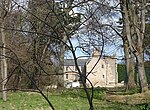Juniper Green railway station
Disused railway stations in EdinburghFormer Caledonian Railway stationsPages with no open date in Infobox stationRailway stations in Great Britain closed in 1943Railway stations in Great Britain closed in 1949 ... and 2 more
Railway stations in Great Britain opened in 1874Use British English from May 2019

Juniper Green railway station was opened in 1874 and served the area of the then village of Juniper Green that now forms part of the city of Edinburgh. Although primarily built as a goods line to serve the many mills on the Water of Leith, a passenger service was provided by the Caledonian Railway using the Balerno Loop and after grouping by the London, Midland and Scottish Railway, seeing formal closure to passenger traffic shortly after nationalisation. The station lay in rural surroundings despite being only a short distance from the centre of Edinburgh and had been popular with families having a day out in the country.
Excerpt from the Wikipedia article Juniper Green railway station (License: CC BY-SA 3.0, Authors, Images).Juniper Green railway station
Water of Leith Walkway, City of Edinburgh Baberton
Geographical coordinates (GPS) Address Nearby Places Show on map
Geographical coordinates (GPS)
| Latitude | Longitude |
|---|---|
| N 55.9031 ° | E -3.2835 ° |
Address
Water of Leith Walkway
Water of Leith Walkway
EH14 5DF City of Edinburgh, Baberton
Scotland, United Kingdom
Open on Google Maps





